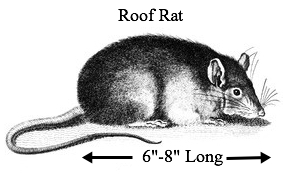Roof Rat Lifespan

During that year however they can create a lot of new rats and a lot of damage.
Roof rat lifespan. Their undersides are often white gray or black. Roof rats are long and thin rodents that have large eyes and ears a pointed nose and a scaly tail. The common lifespan of these rodents is about one year. The black rat sometimes known as a palm rat has a lifespan that rarely exceeds 12 months.
Common causes of death for a rat include vehicles domestic cats and some dogs winged animals such as hawks or owls coyotes foxes weasels and snakes. These bites or scratches can cause what is known as rat bite fever or even tetanus. Roof rats become sexually mature between two and five months producing four to six litters per year that consist of six to eight young each. In dense populations these rodents will establish a social hierarchy wherein dominant males mate more than subordinate males.
Roof rats have soft and smooth fur that is typically brown with intermixed spots of black. The average rat in the wild will live for around one year with female rats often outliving the males. Roof rats are a health hazard being one of the oldest transmitters of diseases. Roof rats get ferocious and tend to bite or scratch when threatened or cornered.
Roof rats are prolific breeders and multiply at a frighteningly fast rate. The black rat rattus rattus also known as ship rat roof rat or house rat is a common long tailed rodent of the stereotypical rat genus rattus in the subfamily murinae. The black rat doesn t typically live longer than a single year. It is a generalist omnivore and a serious pest to farmers because it.
Rarely do rats live for more than a year in the wild. However there are reports of black rats living up to 4 years under captivity. From rat bites and scratches to saliva and urine rats can cause many diseases. So it might be tempting to think that any rat infestation you re dealing with won t ever last longer than that.
Just one adult female can create more than 40 new rats in a year. The black rat is black to light brown in colour with a lighter underside. It likely originated in the indian subcontinent but is now found worldwide.













































